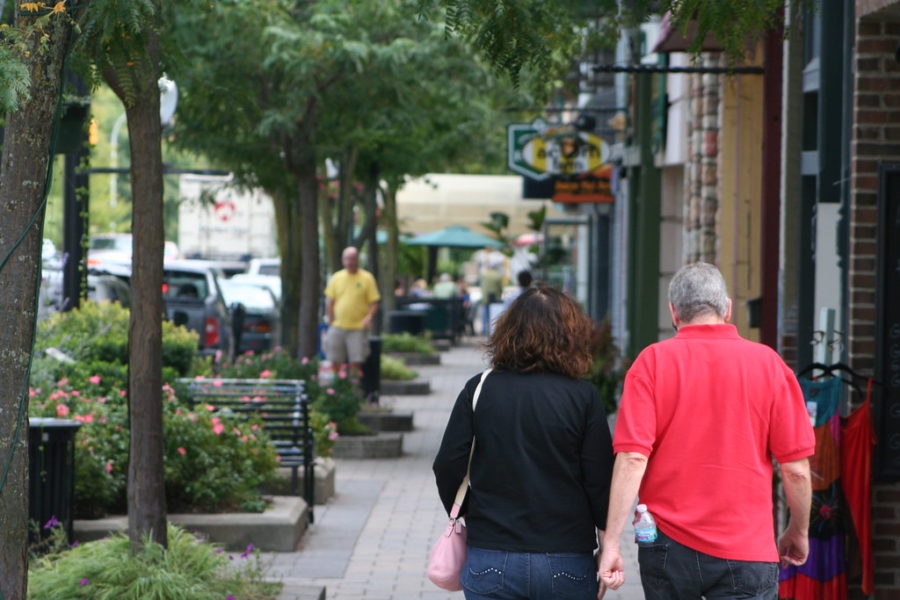Suburbs need more walkability
With the mass introduction of cars and rapid urbanization in the 1950’s, the main transportation method of walking had vanished. Today, when one leaves their home to go to the nearest shop or park, they’d likely find themselves with no choice but to walk in the road or on someone’s lawn, as many streets don’t have sidewalks. America’s sprawling layout and car-based developments are unfriendly for both pedestrians and cyclists.
Unless you live in a dense urban area, you’re unlikely to consider biking or walking to the grocery store or restaurant as it is simply not built with people in mind, rather, vehicles.
Outside of cities, it’s therefore unsurprising that so many people in the United States are left with no option but to be car dependent.
There are very long distances between neighborhoods and shops, and often large parking lots that need to be crossed before reaching the destination. Fast food stores and banks are inconveniently located for pedestrians and are increasingly adding “drive-thru’s” catering to those using a car as their form of transportation. Moreover, walking along busy roads lined with shops feels uncomfortable and dangerous due to the high speeds cars are going at directly beside you, in addition to the lack of bike- friendly lanes.
From my experience living in the suburbs of northern Sydney, Australia, I had access to public transportation such as buses, trains, and ferries that could take me almost anywhere I wanted. In order to use this network of transport options, all I needed was a wallet-sized card that would charge a small fee, based on the length of the trip. It was not necessary to have a car to reach any location as there were paths dedicated to bikes lining every road, protecting cyclists from having to ride directly on the road.
Additionally, sidewalks and bike lanes were plentiful and a safe distance away from cars. Upon moving back to Chicago, I quickly noticed just how striking the ability to safely commute without a car in Australia was compared to the United States. Specifically, the sheer amount of cars, the wider streets, and visible decrease in pedestrians and cyclists outdoors, were very apparent. Further, the vast American parking lots surrounding shopping centers and restaurants can look either desolate or overwhelming.
One benefit of living in a walkable neighborhood is its ability for residents to integrate exercise into daily life. In a 2008 study from the University of Utah, researchers collected data from more than 400,000 adults living in Salt Lake County, testing the walkability of the subjects’ home neighborhoods in correlation to their health. The study found that a man of average height and weight who lived in the most walkable neighborhood in Salt Lake County would be expected to weigh an average of 10 pounds less than a man living in the least walkable neighborhood (University of Utah, 2008).
Although, others may argue that due to Chicago’s high rank of #4 for its current walkable urban development, not much needs to change. However, they are mistaken as nearly all of this development is located in the City of Chicago (Smart Growth America). The suburbs in which many businesses reside and people live in are held at a lesser importance.
Additionally, many people would rather have their own personal car to get to any destination than having to take, plan, and wait for public transportation. However, as research has shown, according to the American Public Transportation Association, having access to low cost transportation such as public buses saves more than $11,000 per year (APTA).
According to a survey conducted by the Urban Land Institute, it was found that 52% of respondents stated that they wanted to live where they don’t need to use a car as often driving between home, work and play. Despite the high demand for a more walkable neighborhood with greater access to public transportation, the supply is not meeting the demand. In order to address this issue, transportation planners must place bus transit in locations that are a reasonable walking distance from homes, allowing for easy pedestrian access.
Further, car-centric suburbs need to make walkability a core principle in their future development plans, which can be achieved through closeness of destination points, presence of parks, and sidewalks along every street. Additionally, the removal of minimum parking requirements from building codes will help lessen car dependency as they occupy space that can be used for housing, allowing for a closer proximity to retail stores, schools, and shops.
The prominent desire to own and use private cars in the suburbs of the United States is due to the lack of available public transportation, and the physical elements of the built environment that make the walking trip unsafe and undesirable. The livelihoods of residents living in these suburbs can only improve once this issue is addressed and solved.









